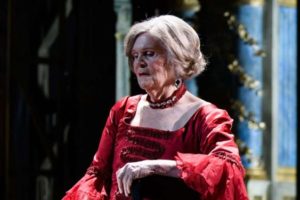
The abrupt withdrawal of Katharina Wagner from an abridged seven-hour Ring cycle she was to direct at the Teatro Colón last year prompted no shortage of scorn and Schadenfreude. It also triggered a salvage operation by director Valentina Carrasco and a creative team that synced half-cooked designs with a patchwork musical score over six weeks to get the show off on time.
Much of the backstage drama is chronicled in a new 93-minute documentary by German producer Hans Christoph von Bock, The Colón Ring: Wagner in Buenos Aires, that may actually surpass the staged production for making the cycle accessible to general audiences. It’s a feel-good celebration of pluck, moxie and improvisation, form-fit to a Glee-like narrative, that’s free of judgments about what’s frankly an artistically dubious project.
Von Bock, retained by Deutsche Welle to chronicle Wagner’s directorial exploits in South America, won the trust of the befuddled international cast and crew after the Bayreuth impresaria summarily walked out on the first day of rehearsal, citing insufficient stage and costume preparation.
What makes the ensuing events more than a routine story of theatrical tsurris is the degree to which the entire team wings it. The musical arrangement by pianist/composer Cord Garben arrived in sorry shape, and the film suggests he provided only limited help correcting errors from afar. Music librarians are shown cutting and arranging parts with the determination of the Iranian students reassembling shredded documents in Argo. Meanwhile, Carrasco has to figure out how to layer her avant-garde take, laced with imagery from recent Argentine history, on a spare revolving stage with tiered platforms that Wagner intended to use to have scenes run parallel to one another. The experienced singers pore over their parts, focusing as much on what’s being left out as what they’re supposed to sing.
Eschewing narration, von Bock uses brisk transitions and lots of establishing shots of the city and theater to take viewers through the preparations, accompanied by ever-present countdown graphics. There’s a reality TV, fly-on-the-wall feel when frustrated conductor Roberto Paternostro walks out of one rehearsal and when word arrives that tenor Torsten Kerl bowed out as Siegmund, prompting a staffer to nonchalantly tear up his dressing room nameplate.
Ms. Wagner comes off as icy and preoccupied in a handful of opening scenes, returning with a lawyer after her walkout to, as she puts it, “clarify the situation” and allow aspects of her konzept to be used. The documentary doesn’t delve much into how Garben thought up the idea of shrinking the tetralogy or managed to get Wagner’s blessing. Von Bock also doesn’t spend an excessive amount of time probing the singers’ thoughts about the undertaking, which bass-baritone Andrew Shore, the Alberich, likens it to trying to driving a car through abrupt gear changes.
The emotional center of the documentary is Carrasco, a diminutive firecracker from La Fura dels Baus, who cajoles and hectors her singers into accepting an approach that sacrifices otherworldy grandeur for gritty historical realism. She dresses Wotan and Fricka as Juan and Eva Peron and portrays the Nibelheim as a military prison where newborns are snatched from dissident parents (the “gold” Alberich steals in the opening scene is also is an infant). The Valkyries appear as Gurkha soldiers from the Falklands War, surrounded by corpses. In the final scene of Gotterdammerung, the treasure is restored when the kidnapped children are reunited with their parents.
Von Bock offsets the artists’ feverish preparation with amusing scenes set to music from the operas. The Valkyries at one point emerge from their hotel rooms en masse and stride into elevators to the strains of their famous Ride. The Siegfried and Mime, Leonid Zakhozhaev and Kevin Conners, work through their scenes together under huge rubber trees in a local park, with Conners obsessing over the German diction. The opening night audience arrives to Fasolt and Fafner’s ominous entrance music.
Garben, in an interview, says he intended to punch up the Ring’s theatrical impact by stripping out philosophical dialogues and scenes in which characters recount past events. That no doubt limited opportunities to probe motives and power struggles or to bring out the conflict between free will and fate that runs through the cycle. It also appears to have left Carrasco reliant on silent movie-like gestures and lots of supernumeraries to convey plot developments.
The excerpts from the prima move with the pace and predictability of an NFL highlight film, making it difficult to draw firm conclusions about the merits of the final product. With her warm and rich middle range and powerful upper register, veteran Brunnhilde Linda Watson clearly dominates her scenes and also displays an earthy sense of humor during her off-stage banter with Carrasco.
Bass Daniel Sumegi pulls triple duty as Fasolt, Hunding and Hagen, helpfully explaining the director’s concept for each heavy during his costume changes and looking quite natural dispatching Siegfried with a golf club. Shore and Conners are excellent as the dwarves while Jukka Rasilainen is stiffer and a bit disconnected as Wotan and the Wanderer. Other principals include Stig Andersen as the replacement Siegmund, Simone Schroder as Fricka, Marion Ammann as Sieglinde and Gary Jankowski as Fafner.
Paternostro leads a beefed-up Teatro Colón orchestra that was split into separate ensembles for Rheingold/Walkure and Siegfried/Gotterdammerung segments, employing brisk tempi and emphasizing the lyrical aspects of the music. The film somewhat predictably ends with footage of wildly applauding audience members, shots of laudatory local newspaper headlines and Carrasco leading the cast in a cathartic scream at a post-curtain dinner.
Teatro Colón artistic director Pedro Pablo Garcia Caffi suggests a bit defensively early in the film that precise, punctual Europeans can learn things about the creative process from their more spontaneous South American colleagues. It’s a nice thought, but the evidence suggests the story of the abridged Ring was less about national identity than a team’s collective professionalism confronting an endeavor that, like a war story, sounds better in the retelling.

























Comments